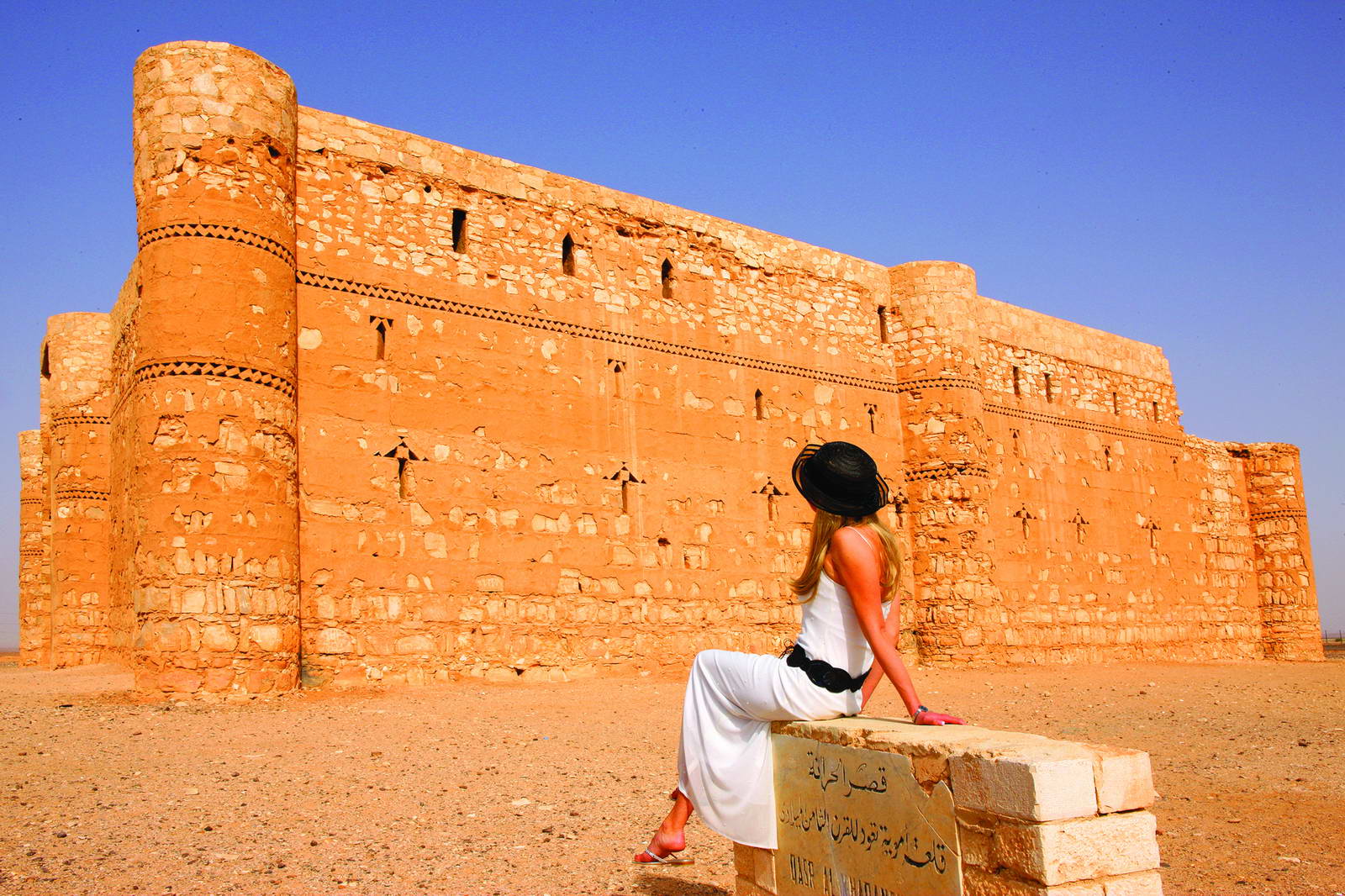Record added successfully



Under the Caliph Omar's rule, the region of Jordan, Palestine, and Greater Syria were conquered. The Umayyad dynasty came into existence under Muawiya, who subsequently moved the capital north to Damascus.
This shifted the power of the Islamic Empire north from the Hijaz. They became a part of the Umayyad Dynasty, the first of the Islamic dynasties.
The Umayyads successfully ruled a vast empire for a total of ninety years. The monuments in Jordan were the beginning of the development of the Islamic art and architecture. These desert castles represent the early Islamic art. There was an abundance of decoration, including mosaics, frescoes, stone and stucco carving. Illustrations depicting man, animals, and geometric patterns borrowed from both Persian and Graeco - Roman traditions. These desert complexes, often referred to as castles, served various purposes. It is believed that some may have been built as caravan stations, others to support agriculture, some as resort pavilions, some in order to forget the troubles of life, and some to house traders. These monuments stand as a reminder of the earliest days of the Islamic empire and of a short-lived dynasty whose base lay in the region. The most important of these palaces are Mushatta, Kharranah, Amra and others.
Umm El-Jimal is located in the north-east of Amman and east of Mafraq. It is built of black basalt. During the Nabataean Period, it became a major commercial and military settlement. In the Byzantine Period, it was a Christian center and churches were built in it. In the eight century AD, Umm El-Jimal was destroyed by an earthquake.
Qasayr Amra, a UNESCO World Heritage Site, is thought by most experts to have served as a hunting lodge and bathhouse. It is situated in Wadi Butm, which is named for the wild pistachio trees that now hide deep in the wadi behind the castle. Qasayr means "little castle," meaning that this structure was smaller than the others in the Ummayad network, and it is thought to have been part of a larger complex, including a fort and living quarters, originally built under Caliph Walid I in 711. Amra houses some of the earliest examples of figurative art from the Islamic era, just predating the edict of Caliph Yazid II (720-724), who ordered the destruction of artistic images. Fortunately, the edict was primarily applied to religious buildings.
The frescoes are joyous and fascinating, with evidence of Byzantine and Persian influences. There are hunting scenes, including one of onagers being driven into a trap; athletes pursuing their sports; musicians, dancers, and craftsmen; animals, including a charming bear playing a guitar, and in the baths, various people going about their own ablutions. Six figures seem to represent rulers that Walid I either respected or had defeated: the Byzantine emperor, Caesar; the Visigoth King Roderick; Choroes, the Persian emperor; the Negus of Abyssinia, and possibly the emperor of China and the Turkish khan. The frescoes, which measure 350 square meters, were restored in the 1970s by a team of experts from the Madrid National Archeological Museum. Outside the Qasr Amra is a 40-meter deep well, which was powered by draft animals, ensuring a source of water for the baths. Inside is an audience hall, a bathhouse, and meeting rooms. The hall has a triple vaulted ceiling covered in frescoes. The bathhouse has three sections: the apodyterium, for changing clothes; the tepidarium, for warm water; and the caldarium, for hot water. The domed roof of the caldarium portrays the heavens at night, one of the earliest known representations of the sky on a curved surface. It shows the signs of the zodiac and many constellations. The meeting rooms have mosaic floors
This is one of the finest or the Umayyad «desert resort pavillons.» The interior of this bathhouse reveals a breathtaking treasure of splendid sensuous frescoes from the mid-8th century. The buildings were constructed of limestone, yet the real attraction to Qusair Amra are the extensive frescoes. Hunting scenes with wild onagers being driven into a net trap by men on galloping horses; women in bathing scenes; athletes demonstrating their collective prowess in an outdoor setting; the goddesses of poetry, philosophy and history; musicians and dancers together with exotic birds and plants; and, finally, the famous «fresco of the six kings,» representing the rulers of the world, including the Byzantine Emperor and the Emperor of China. A female figure representing Victory, flanked by servants and peacocks, dominates the audience hall. This example illustrates the Umayyad use of borrowed iconography from Persian and Greco-Roman art. In the innermost caledarium is the small but magnificent «dome of heaven.» This is one of the first representations of the heavens on a domed ceiling. Central in the map is the North Star that is surrounded by the northern hemisphere and signs of the Zodiac. Survivors of the censorship of later, more puritanical periods, these frescoes reveal the brilliant eclecticism of early Arab/Islamic art. Little wonder that Qusair Amra was declared a Unesco World Heritage Site.
Qal at al-Azraq is located on the ancient main trade route. Pools of fresh water, now depleted, made it the largest oasis in the Jordanian desert. These pools of water gave name to the castle, which means blue in Arabic. There is indication that this area was used as a main center prior to Roman times. It is believed to have been rebuilt during the reign of Constantine and served as a defensive military fortress overlooking the trade route. The fort was rebuilt in the 13 century by the Ayubbids. Qal at al-Azraq enjoys global fame for having been the headquarters of Sheriff Hussein of Mecca and T.E. Lawrence, better known as «Lawrence of Arabia.» Lawrence described the fort as «the blue fort on its rock above the rustling palms, with the fresh meadows and shining springs of water,» Inside the black basalt stone fortress, the room directly above the entrance gatehouse is thought to have been used by Colonel Lawrence. Traces of the people who built and settled in this fort can be found scattered throughout. Opposite the entrance, to the left, is the basalt altar that is split in two. The lower portion is in Greek, while the upper portion in Latin. This altar dates the fort to the third century under the Roman Empire.
Azraq is located fortuitously on the trade route to Syria and Mesopotamia in Wadi Sirhan, next to an oasis. While the first fort here may have been built by Severus at the end of the 2nd century as a defense of the limes arabicus, a later one was built by Diocletian in the late 3rd century, perhaps to compliment his new road, the Strata Diocletania, which stretched between Azraq and Syria. Both the Byzantines and the Ummayads used this fort, Caliph Walid II primarily for hunting. However, in 1237, the Ayyubid governor Azz al-Din Aybak rebuilt the fort, according to an inscription above the main entrance. Most visitors come here, however, because in 1917-1918 T. E. Lawrence and Sherif Hussein bin Ali used Azraq as their base during the Great Arab Revolt. While the building was three stories high and had the original Roman black basalt doors to protect them, there was little insulation against the cold, and their men patched the holes in the walls with palm fronds and clay. From here in September 1918 they marched on Damascus, loosening forever the hold the Ottomans held on the region. The building was partially destroyed in an earthquake in 1927.
The black basalt makes this castle distinctive from the others, as does the fact that the town of Azraq has grown up around it, so it lacks the isolation of Kharana or Amra. Some of the paving stones in the main entrance still show the holes former gatekeepers carved in them so that they could play games to while away the time. Lawrence inhabited the room above the main entrance. A small 3rd century Roman altar is opposite the entrance, and a 13th century mosque, built over a Byzantine church, is in the courtyard. Other residential areas are primarily in the northern section, including a room housing some of the more beautifully carved stone decorations, including a ram and a mermaid, and steps leading to a well are in the northeast corner of the courtyard. The prison ruins are in the northwest corner. The Ummayad Castles are a wonderful reason to visit the eastern desert. Whether used for defense or relaxation, they give a glimpse into a world few were privileged to see. The tall walls of Kharana, the frescoes of Amra, and the historical associations of Azraq make this journey rich and rewarding.
Qasr Kharana lies 55 km east of Amman. Two stories high, with puissant stone walls interspersed with rounded interval and corner towers, this caravanserai, like some other desert castles, was never fully completed. Qasr Kharana is Built of limestone rubble and mortar, Kharana is a small castle of 35 m. square. An arched passageway serves as an entrance for the castle. Flanked by two large rooms on both sides, these are believed to have been stable and storage rooms. Inside, 61 rooms overlook the central courtyard, most of them arranged in suites of four or five communicating rooms around a large hall. From the courtyard, two low - angled, long staircases lead up to the second store and the roof. Some of the rooms on the second floor maintain their original decorative stone - work, with colonnettes, rosette friezes, semi-domed ceilings, and inscriptions. The building indicates both Syrian and Iraqi influences and the second floor remains unfinished.
Qasr Al-Mushatta is situated just north of Queen Alia International Airport s north runway. Never completed, the castle is thought to have been initiated by Caliph Walid II around 743-744 AD, just before the Umayyed dynasty gave way to the power of the Baghdad-based Abbassid rulers. It is believed to have been planned on a magnificent scale. Examples of the fusion of classical art and Islamic geometric patterns are represented here. Some pieces of finely carved stone with floral, animal and geometric motifs, including bold rosettes, looped grape-laden vine-stalks, and acanthus leaves still remain. As Qasr Al-Mushatta appears from the foundation stones and the standing ruins, the only gate seems to have led through a series of rooms, courts and passageways into a tripleapsed «throne room.» A mosque and small pool were located just inside. At the back of the hall are the latrines of Mushatta that provides a glimpse into the daily life of the early inhabitants. Qasr-AL-Mushata
References: Does your Jordan Pass cover your visit to Little Petra in 2023? A comprehensive guide.